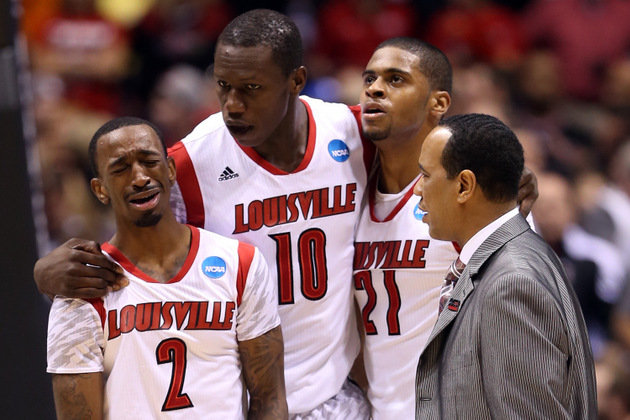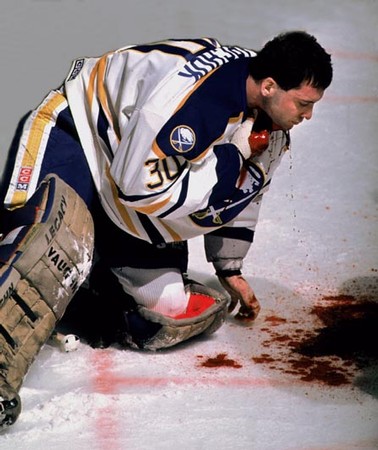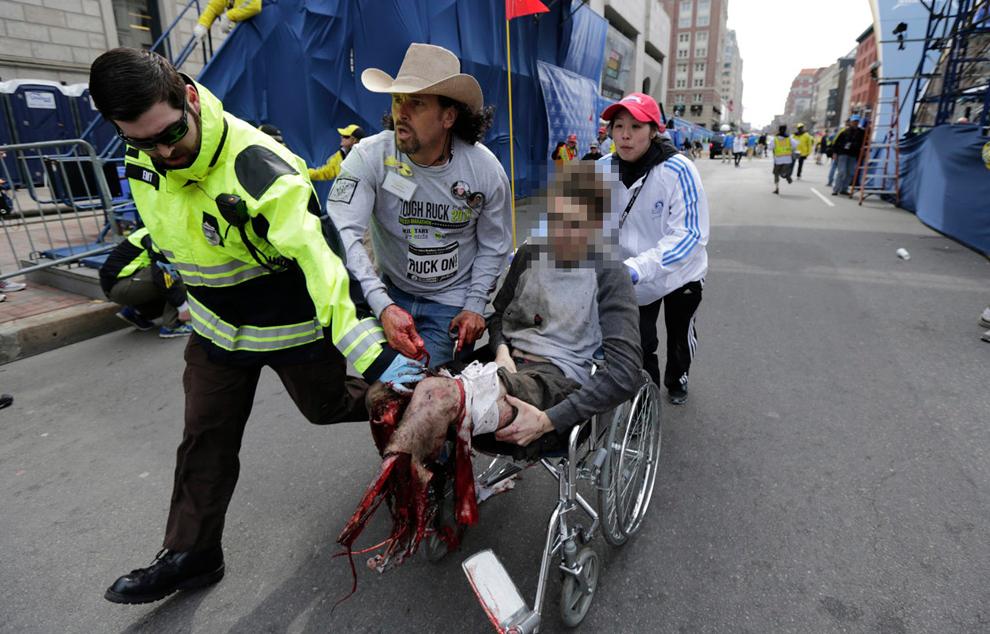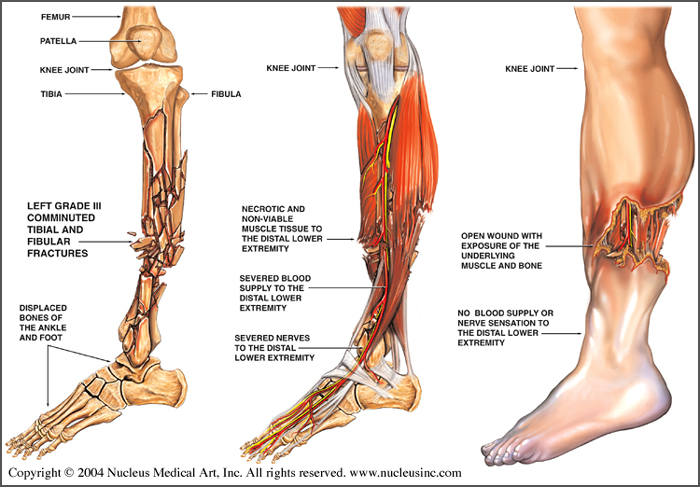Site informationRecent Blog Posts
Blog Roll
|
Violent Encounters
Submitted by Laura Thain on Fri, 2013-04-19 17:39
Louisville Cardinal players react to Kevin Ware's leg injury during March Madness. Image Credit: Yahoo Sports I’ll admit, I stayed up way past my bedtime last night listening to the Boston police scanner, following as closely as I could the developments in the Boston Marathon bombing. In the wee hours of this morning, I thought about documenting the dozens of news items (as well as widespread speculation across message boards and social media) to take a tally of how much of the information proliferating in the uncertainty of Friday morning would be disproved by Friday afternoon. As I began the project, it soon proved futile—there was far too much information and I ran into (as I might have anticipated) problems discerning journalistic fact from fiction right from the get go. It was only when I stopped documenting and trying to quantify the evidence that I began to think about the relationship between violence and speculative practice and assemble a quite different archive. [GORE WARNING: the images beyond this cut are NSFW and may shock and disturb some viewers. Discretion is advised.] What appears here is a somewhat experimental exercise in assembling and reading images of violence and gore. The images below all represent some intersection of sport, violence, and speculative practice. Let me explain why I’ve picked them.
Image Credit: Tumblr Sporting events are ritualized violence. Sporting events contain and set limits on the violent impulses of society, translating violence into spectacle for mass consumption and participation. It is for this reason that when violence occurs outside of the set script of the sporting event, the results are often traumatic for both the participants and the audience. Non-scripted displays of violence bring attention to the unstable nature of “appropriate” and “inappropriate” displays of violence. They also cause us to question the ethics of our consumption of violence by juxtaposing structural and non-structural violence; the pleasure of one is interrupted by the horror of another when we witness violence on the playing field. Let’s look at an example of unscripted violence before the age of the internet: The video above shows goaltender Clint Malarchuk during a 1989 Sabres game against the St Louis Blues. In a freak accident, the Blues’ right wing slashes Malarchuk’s throat with his skate, severing his jugular vein and very nearly killing him. Note that the announcers demand the camera pan away from the accident and immediately begin to play a radio ad for Buick over the noice of the crowd’s reaction. Those present in the stands witnessed “many spectators physically sickened by the sight [of Malarchuk’s injury]. 11 fans fainted, 2 more suffered heart attacks and 3 players vomited on the ice.” Present-day broadcast media is far less likely to pan away from injury in this manner. Kevin Ware’s NCAA March Madness injury, for instance, was replayed several times as they carried Ware away in a stretcher. How can we account for the dramatic difference in the way violence is portrayed and mediated now? Speculative practice can help assuage anxiety about the unstable line between scripted and non-scripted violence. When audiences engage in speculative practice about violence that occurs outside the realm of accepted social practice, they are asserting their own boundaries between appropriate and inappropriate engagements in violent behavior. In this way, speculative practice can help create a crowd-sourced discursive boundary where institutional boundaries fail—that is, these institutional boundaries are either inadequate or are subverted by violent offenders. Speculative practice in response to violence is multi-faceted; it can pursue a variety of solutions to the breach of the code of institutionalized violence. Tactical approaches can seek to bring violent offenders to justice, but they just as often can seek to levy judgment and punishment independent of institutional authority (i.e. vigilantism). Speculative practice is not, however, always tactical. Speculative practice can happen in sustained, maintained alternative media outlets (reddit, 4chan, conspiracy theory hubs, etc.). Often, speculation serves as a tool to process trauma among online communities that have established relationships with each other (reddit), although it can also happen in settings in which users operate in anonymity (4chan). With these three principles in mind, let’s turn first to the case of Kevin Ware, the Louisville guard who suffered a dramatic compound leg fracture during March Madness. Note, as I’ve mentioned earlier, the repeated replay of the injury, as well as the announcer’s focus on the absolute horror of Ware’s Louisville teammates. Spectators reported seeing his teammates vomit and other audience members lose consciousness at the sight of Ware’s injury.
Image Source: Imgur High-resolution pictures of Ware’s injury were posted to Reddit immediately after Ware sustained his injury, and in a 2,000 long comment chain, redditors weighed in on the injury. The top-ranked comments on Reddit regarding Ware’s injury were, strangely, not the ones that relished/disgusted in the gore of the injury. Instead, the top comments speculated on Ware’s medical prognosis. Redditors with a wide variety of medical experience made predictions about Ware’s ability to play again, why the wound bled so little, how the wound might be best healed, etc. Commentors also praised Ware for remaining stoic—for “performing” away the injury. Though the image was clearly posted and became viral because of its gruesome nature, we can see from the example of Reddit that the audience’s speculation attempted to “heal” the wound discursively. The practice of speculation also helps us understand the extreme viral interest in and disgust about Ware’s wound as somehow reflective of a hierarchy of trauma. In general, as exhibited in the case of Ware, twisted or maimed bodies, especially limb injuries, rank higher on the gore scale than mere blood, head injuries, or dead bodies. Why? Because while we might reconstruct a maimed limb with speculative practice—be disturbed by its “inside out nature,” but comforted by the ability to right the inversion—we cannot repair blood spilt or life lost. The horror of seeing a body disarticulated from itself is more immediate but less final than a whole body stripped not of limbs but of life. The extreme reaction to a Ware’s ghastly injury resembled a similar discussion on Reddit about the following victim of the Boston Marathon bombings:
Image Credit: Imgur The disarticulation of this man’s legs became the most viewed and commented on image from the carnage following the bombing. And although photos in the same series (also posted to the same /wtf/ board on Reddit as the Ware photos) capture dead or nearly dead bodies, viewers find the spectre of dismemberment far more disturbing.
Image Source: Hug-a-Leg Again, the top comments speculate on healing—they individualize each victim and speak of their chances for survival, the techniques they hope the paramedics used, the treatment they hope the victims are receiving, etc. In displaying medical knowledge (credible or otherwise), users attempt to, from their computer screens, heal the broken bodies of the victims of the bombing. Speculative practice can also have very real effects on how a population deals with the aftermath of a trauma. On Thursday, 4chan’s /b/ board released detailed interpretations of FBI-released footage and claimed that the board on the whole had identified the “most likely” (that is, “99% confirmed) suspect. 4chan’s attempt at vigilante justice arguably created only more chaos (as parodied by The Onion here) and, despite claims of 99% accuracy, it took only 24 hours for the /b/ board’s claims to be disproved. Perhaps I can end by suggesting that 4chan’s speculative practice may demonstrate an important issue for further discussion: that while a shift in the distance between violent act and viewer might result in different responses to that violence, the only way to decrease violent acts in society is to address candidly the disjunction between what constitutes state sponsored, socially-sanctioned violence and non-state sponsored, non-socially sanctioned violence.
Image Source: Designation Systems Maybe we can start by ditching the drones. |
viz.
Visual Rhetoric - Visual Culture - Pedagogy
Site informationRecent Blog Posts
|
Violent Encounters |






Recent comments
2 years 29 weeks ago
2 years 44 weeks ago
2 years 44 weeks ago
2 years 50 weeks ago
3 years 4 weeks ago
3 years 4 weeks ago
3 years 4 weeks ago
3 years 6 weeks ago
3 years 6 weeks ago
3 years 6 weeks ago